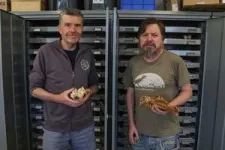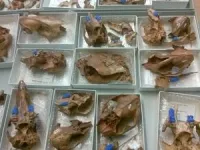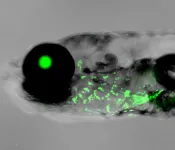(Press-News.org) Prehistoric kangaroos in southern Australia had a more general diet than previously assumed, giving rise to new ideas about their survival and resilience to climate change, and the final extinction of the megafauna, a new study has found.
The new research, a collaboration between palaeontologists from Flinders University and the Museum and Art Gallery of the Northern Territory (MAGNT), used advanced dental analysis techniques to study microscopic wear patterns on fossilised kangaroo teeth.
The findings, published in Science, suggest that many species of kangaroos were generalists, able to adapt to diverse diets in response to environmental changes.
More images at the link https://www.dropbox.com/scl/fo/2ct8c650h8w9a3v1hp6zk/ABHEvol8_qkUFzcucnwp80w?rlkey=ycp2v63ypaoy0spik6qodxd9k&st=v371t1hx&dl=0
The article, ‘Dietary breadth in kangaroos facilitated resilience to Quaternary climatic variations’ (2025) by Samuel D Arman, Grant J Gully and Gavin A Prideaux has been publishing in the journal Science DOI: 10.1126/science.adq4340
Acknowledgements: Funding for the study was provided by the Australian Research Council grants to Prof Prideaux (DP110100726, DP190103636, FT130101728 and LE130100115). Dr Arman and Mr Gully were supported by Flinders University Research Scholarships.
The authors acknowledge the Meintangk, Marditjali and Potaruwutj, the traditional custodians of the Naracoorte region – and thank the volunteers, students and scientists who collected and prepared specimens from the Victoria Fossil Cave. The project is part of a long-running partnership between Flinders University and MAGNT, combining innovative techniques with expertise in palaeontology to deepen our understanding of Australia’s unique prehistoric ecosystems.
The research focused on fossil kangaroo species from the renowned Victoria Fossil Cave at the Naracoorte Caves World Heritage Area in South Australia and refutes the long-held idea that those species that did not survive past 40,000 years ago became extinct because they had specialised diets.
The Naracoorte Caves World Heritage Area of southeastern South Australia contains the richest and most diverse deposit of fossil kangaroos known from the Pleistocene (2.6 million to 12,000 years ago).
“Our study shows that most prehistoric kangaroos at Naracoorte had broad diets. This dietary flexibility likely played a key role in their resilience during past changes in climate,” says lead researcher Dr Sam Arman, from MAGNT in Alice Springs and Flinders University.
Using Dental Microwear Texture Analysis, the team compared the diets of 12 extinct species with those of 17 modern species. The results contradict previous assumptions that certain species went extinct due to their specialised diets. Instead, the study found that most species were mixed feeders, capable of consuming a combination of shrubs and grasses.
“The distinctive short-faced kangaroo anatomy led to a widespread view that sthenurines were unable to adapt their diets when climate change altered vegetation patterns, leading to their extinction,” says co-author Professor Gavin Prideaux from Flinders University.
“By shedding light on the ecological roles of Australia’s marsupial megafauna, we will develop a better understanding of how its modern ecosystems evolved. Among other things, this might help to contextualise why Australia has been so vulnerable to introduced large mammals, such as pigs, camels, deer and horses.”
“Most of the Naracoorte kangaroo species actually had similar everyday diets, which would reflect foods that were most nutritious and readily accessible,” adds Dr Arman.
“Having the hardware though, to eat more challenging foods would have helped them get through seasons or years when their preferred food was rare. An analogy might be my 4x4. Most of the time, I don’t need to engage four-wheel drive, but this capability becomes crucial when I do need it.”
“The Victoria Fossil Cave was an ideal place to start. It’s the locality with the greatest available sample to get a good look at Pleistocene diets for a large number of species. We hope to extend this dataset to other Pleistocene deposits across Australia, especially those that span the interval 60,000 to 40,000 years ago when many megafaunal species became extinct,” he says.
While diet may still have played a role, determining extinction will likely involve better understanding other attributes, like body size and locomotion, and how these interacted with Pleistocene environments and the arrival of humans.
Another author, Flinders Palaeontology Lab manager and curator Grant Gully, says the new research, which applied the “powerful analytical and modelling methods to a massive sample of 2650 kangaroo tooth scans” supports “an important step in understanding the ecology of Australian megafaunal species”.
“This allowed us to capture the degree to which diets vary between individuals and regions for modern species, and then use this as a basis for investigating diets of fossil species through time.”
END
Did prehistoric kangaroos run out of food?
Dental records reveal a more diverse grazing diet than previously thought
2025-01-09
ELSE PRESS RELEASES FROM THIS DATE:
HKU Engineering Professor Kaibin Huang named Fellow of the US National Academy of Inventors
2025-01-09
The US National Academy of Inventors (NAI) announced the 2024 Class of Fellows on December 10, 2024. Professor Kaibin Huang of the Department of Electrical and Electronic Engineering (EEE), Faculty of Engineering, the University of Hong Kong (HKU), was elected a 2024 Fellow in recognition of his inventions and contributions in tackling real-world issues.
Election to NAI Fellow status is the highest professional distinction accorded to academic inventors who have demonstrated a prolific spirit of innovation in creating or facilitating outstanding inventions that have made a tangible impact on ...
HKU Faculty of Arts Professor Charles Schencking elected as Corresponding Fellow of the Australian Academy of Humanities
2025-01-09
Professor Charles Schencking, Professor of History of the Faculty of Arts at the University of Hong Kong (HKU), has been elected as a Corresponding Fellow of the Australian Academy of Humanities (the Academy).
The Australian Academy of the Humanities was established in 1969 by Royal Charter to advance knowledge of, and the pursuit of excellence in, the Humanities. It is an independent, not-for-profit organisation with a Fellowship of over 730 distinguished humanities researchers, leaders, and practitioners ...
Rise in post-birth blood pressure in Asian, Black, and Hispanic women linked to microaggressions
2025-01-09
A study of more than 400 Asian, Black and Hispanic women who had recently given birth found that racism through microaggressions may be linked to higher blood pressure during the period after their baby was born, according to a new study by Columbia University Mailman School of Public Health. More than one-third of the mothers reported experiencing at least one microaggression related to being a woman of color during or after their pregnancy. The research conducted with colleagues at the University of Pennsylvania ...
Weight changes and heart failure risk after breast cancer development
2025-01-09
About The Study: In this nationwide cohort study in the Republic of Korea, postdiagnosis weight gain was associated with an increased risk of heart failure after breast cancer development, with risk escalating alongside greater weight gain. The findings underscore the importance of effective weight intervention in the oncological care of patients with breast cancer, particularly within the first few years after diagnosis, to protect cardiovascular health.
Corresponding Author: To contact the corresponding author, Dong Wook Shin, MD, DrPH, MBA, email dwshin@skku.edu.
To access the embargoed study: Visit our For The Media website at this ...
Changes in patient care experience after private equity acquisition of US hospitals
2025-01-09
About The Study: This study found that patient care experience worsened after private equity acquisition of hospitals. These findings raise concern about the implications of private equity acquisitions on patient care experience at U.S. hospitals.
Corresponding Author: To contact the corresponding author, Rishi K. Wadhera, MD, MPP, MPhil, email rwadhera@bidmc.harvard.edu.
To access the embargoed study: Visit our For The Media website at this link https://media.jamanetwork.com/
(doi:10.1001/jama.2024.23450)
Editor’s Note: Please see the article for additional information, including other authors, author contributions and affiliations, ...
COVID-19 vaccine hesitancy among Black women in the US
2025-01-09
About The Study: The results of this study suggest that addressing COVID-19 vaccine hesitancy among Black women requires a multifaceted approach that acknowledges historical traumas, provides clear and transparent safety information, and avoids coercive vaccine promotion strategies. These findings emphasize the need for health care practitioners and public health officials to prioritize trust-building, engage community leaders, and tailor interventions to address the unique concerns of Black women to improve vaccine confidence and uptake.
Corresponding Author: To contact the corresponding author, Brittany C. Slatton, PhD, email brittany.slatton@tsu.edu.
To access the ...
An earful of gill: USC Stem Cell study points to the evolutionary origin of the mammalian outer ear
2025-01-09
The outer ear is unique to mammals, but its evolutionary origin has remained a mystery. According to a new study published in Nature from the USC Stem Cell lab of Gage Crump, this intricate coil of cartilage has a surprisingly ancient origin in the gills of fishes and marine invertebrates.
“When we started the project, the evolutionary origin of the outer ear was a complete black box,” said corresponding author Crump, professor of stem cell biology and regenerative medicine at the Keck School of Medicine of USC. “We had been studying the development and regeneration of the jawbones of fishes, and an inspiration for us was Stephen ...
A Sustainable Development Goal for space?
2025-01-09
Scientists have called for the designation of a new United Nations Sustainable Development Goal (SDG) with the aim to conserve and sustainably use Earth's orbit, and prevent the accumulation of space junk.
There are currently 17 SDGs, adopted by UN members in 2015 as a universal call to action to end poverty, protect the planet for future generations, and ensure all people enjoy peace and prosperity.
But with growing numbers of satellites and other objects now orbiting our planet, there is growing concern that without some form of global consensus ...
The Balbiani body: Cracking the secret of embryonic beginnings
2025-01-09
Researchers have uncovered how egg cells prepare for the creation of life. Their work reveals the secrets of the Balbiani body, a remarkable structure that organizes essential molecules to guide early embryonic development. Using zebrafish models and cutting-edge imaging, the team discovered how this structure transforms from liquid droplets into a stable core, laying the groundwork for life itself. This discovery sheds light on the extraordinary precision of nature’s reproductive process.
A new study led by Prof. Yaniv Elkouby and his team, including first co-authors Swastik Kar and Rachael Deis, from the Faculty of Medicine at the Hebrew University ...
Science behind genetic testing for identifying risk of opioid misuse remains unproven
2025-01-09
PHILADELPHIA—Opioid misuse and specifically opioid use disorder (OUD), continues to represent a significant U.S. public health threat, with more than 6 million Americans aged 12 and older meeting the criteria for OUD in 2022. Efforts to ease the crisis have included the development of genetic testing to identify individuals most at risk for OUD. New research, out today in JAMA Network Open, questions the usefulness of 15 genetic variants from an algorithm meant to predict OUD risk that was recently granted pre-marketing approval by the Food and Drug Administration. It found that the testing could lead to both false positive and false negative results.
The study was led by Christal ...
LAST 30 PRESS RELEASES:
How talking slows eye movements behind the wheel
The Ceramic Society of Japan’s Oxoate Ceramics Research Association launches new international book project
Heart-brain connection: international study reveals the role of the vagus nerve in keeping the heart young
Researchers identify Rb1 as a predictive biomarker for a new therapeutic strategy in some breast cancers
Survey reveals ethical gaps slowing AI adoption in pediatric surgery
Stimulant ADHD medications work differently than thought
AI overestimates how smart people are, according to HSE economists
HSE researchers create genome-wide map of quadruplexes
Scientists boost cell "powerhouses" to burn more calories
Automatic label checking: The missing step in making reliable medical AI
Low daily alcohol intake linked to 50% heightened mouth cancer risk in India
American Meteorological Society announces Rick Spinrad as 2026 President-Elect
Biomass-based carbon capture spotlighted in newly released global climate webinar recording
Illuminating invisible nano pollutants: advanced bioimaging tracks the full journey of emerging nanoscale contaminants in living systems
How does age affect recovery from spinal cord injury?
Novel AI tool offers prognosis for patients with head and neck cancer
Fathers’ microplastic exposure tied to their children’s metabolic problems
Research validates laboratory model for studying high-grade serous ovarian cancer
SIR 2026 delivers transformative breakthroughs in minimally invasive medicine to improve patient care
Stem Cell Reports most downloaded papers of 2025 highlight the breadth and impact of stem cell research
Oxford-led study estimates NHS spends around 3% of its primary and secondary care budget on the health impacts of heat and cold in England
A researcher’s long quest leads to a smart composite breakthrough
Urban wild bees act as “microbial sensors” of city health.
New study finds where you live affects recovery after a hip fracture
Forecasting the impact of fully automated vehicle adoption on US road traffic injuries
Alcohol-related hospitalizations from 2016 to 2022
Semaglutide and hospitalizations in patients with obesity and established cardiovascular disease
Researchers ‘listen in’ to embryo-mother interactions during implantation using a culture system replicating the womb lining
How changing your diet could help save the world
How to make AI truly scalable and reliable for real-time traffic assignment?
[Press-News.org] Did prehistoric kangaroos run out of food?Dental records reveal a more diverse grazing diet than previously thought




